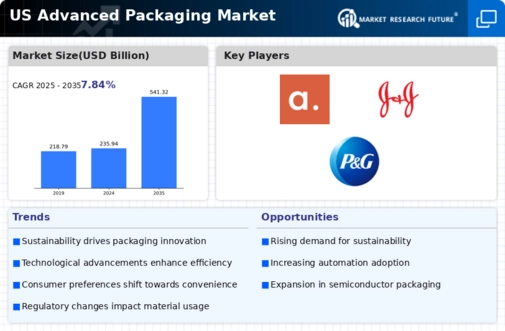Consumer Preference for Convenience
Consumer preferences are evolving towards convenience, which is driving changes in the advanced packaging market. As lifestyles become increasingly fast-paced, there is a growing demand for packaging that offers ease of use, portability, and functionality. Products that feature resealable, single-serve, or easy-to-open designs are gaining popularity among consumers. In the US, the convenience packaging segment is expected to account for a substantial share of the market, with projections indicating a growth rate of 8% annually through 2026. This shift in consumer behavior is prompting manufacturers to rethink their packaging strategies, focusing on designs that enhance user experience while maintaining product integrity. Consequently, the advanced packaging market is likely to witness a surge in innovative solutions that cater to the convenience-driven consumer.
Rising E-Commerce and Online Retail
The surge in e-commerce and online retail is significantly impacting the advanced packaging market. As consumers increasingly prefer online shopping, the demand for packaging solutions that ensure product safety during transit is escalating. In the US, e-commerce sales are projected to exceed $1 trillion by 2025, necessitating innovative packaging solutions that can withstand the rigors of shipping. This trend is prompting companies to invest in advanced packaging technologies that provide enhanced protection and reduce waste. Additionally, the need for efficient packaging that facilitates easy returns is becoming paramount. As a result, the advanced packaging market is likely to see a shift towards solutions that cater specifically to the unique challenges posed by e-commerce logistics.
Technological Advancements in Packaging
Technological advancements are playing a pivotal role in the evolution of the advanced packaging market. Innovations such as smart packaging, which incorporates sensors and indicators, are enhancing product safety and shelf life. The integration of Internet of Things (IoT) technology allows for real-time monitoring of product conditions, thereby improving supply chain efficiency. In the US, the smart packaging segment is expected to grow at a CAGR of 12% from 2025 to 2030, reflecting the increasing adoption of these technologies. Furthermore, advancements in materials science are leading to the development of lighter, stronger, and more versatile packaging solutions. As companies strive to differentiate their products in a competitive market, the incorporation of cutting-edge technologies is likely to become a key driver in the advanced packaging market.
Growing Demand for Eco-Friendly Solutions
The advanced packaging market is experiencing a notable shift towards eco-friendly solutions, driven by increasing consumer awareness regarding environmental sustainability. As more companies adopt sustainable practices, the demand for biodegradable and recyclable packaging materials is on the rise. In the US, the market for sustainable packaging is projected to reach approximately $400 billion by 2027, indicating a robust growth trajectory. This trend is further fueled by regulatory pressures and consumer preferences for products that minimize environmental impact. Consequently, manufacturers in the advanced packaging market are innovating to develop materials that not only meet performance standards but also align with eco-conscious consumer values. This growing demand for eco-friendly solutions is likely to reshape the competitive landscape, compelling companies to invest in research and development to create sustainable packaging alternatives.
Regulatory Compliance and Safety Standards
Regulatory compliance and safety standards are increasingly influencing the advanced packaging market. As governments and regulatory bodies implement stricter guidelines regarding food safety, product labeling, and environmental impact, companies are compelled to adapt their packaging solutions accordingly. In the US, the Food and Drug Administration (FDA) has established comprehensive regulations that govern packaging materials, particularly in the food and pharmaceutical sectors. This regulatory landscape is driving innovation as manufacturers seek to develop compliant packaging that meets safety standards while also appealing to consumers. The need for transparency and traceability in packaging is becoming paramount, leading to the adoption of advanced materials and technologies. As a result, the advanced packaging market is likely to experience growth driven by the necessity for compliance with evolving regulations.














Leave a Comment